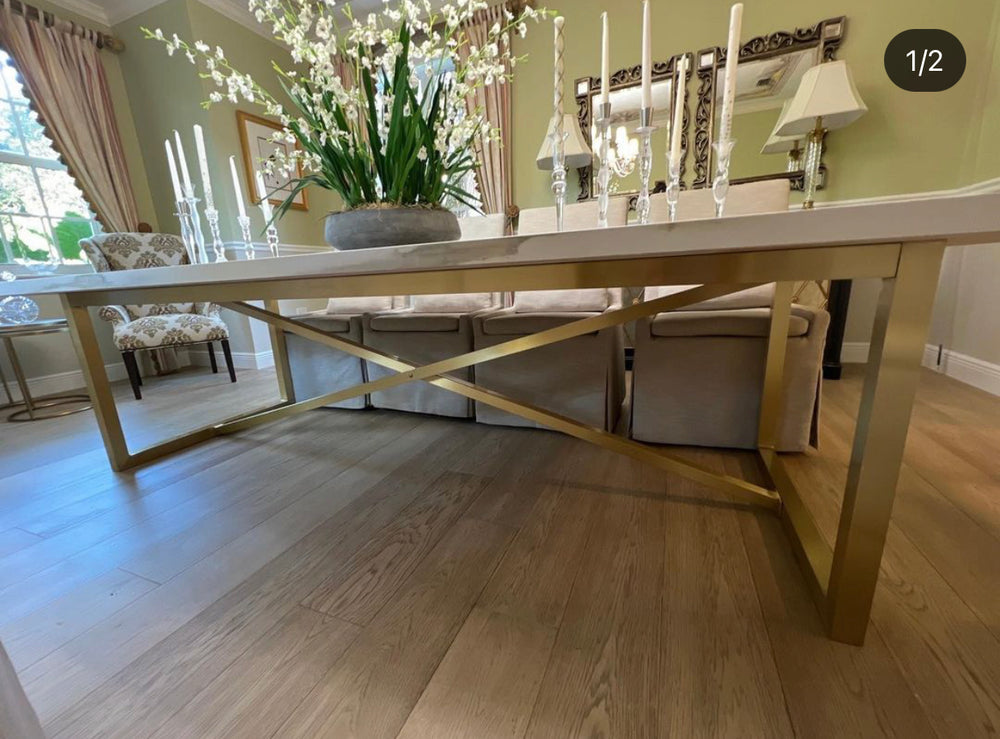Discover the Best Products for Dining Room Table Legs for Every Style
Discover the Best Products for Dining Room Table Legs for Every Style
Blog Article
A Detailed Take A Look At Table Leg Styles: Locating the Perfect Match
Selecting the appropriate eating table leg style is important for both aesthetic allure and functional performance. Traditional 4 legs use timeless style and security, while the pedestal base gives boosted legroom and a modern appearance. For those with bigger tables, trestle legs make sure strong assistance, whereas barrette legs introduce a mid-century modern ambiance with their minimal design. The x-shaped legs blend contemporary design with enhanced stability. Each of these alternatives brings distinct advantages, making the option greater than simply a matter of choice. Explore additionally to discover which design perfectly matches your eating area and way of living.
Typical 4 Legs
Amongst the different types of dining table leg styles, the traditional four-leg layout continues to be a classic option for numerous homes. Four legs give well balanced assistance, guaranteeing the table remains secure and capable of bearing substantial weight (dining room table legs).
From a visual point of view, the conventional four-leg layout can be conveniently adjusted to different interior designs. Whether crafted from wood, metal, or a mix of products, these legs can be intricately sculpted, streamlined and minimalistic, or anything in between. Their adaptability allows them to enhance both rustic and modern settings seamlessly.
In addition, the simple structure of the four-leg layout assists in ease of activity and placement within an area. Unlike even more complex bases, this design reduces blockages, supplying ample legroom for restaurants. In summary, the typical four-leg dining table leg design marries sustaining sophistication with practical functionality, making it a sharp choice for those looking for both form and function in their eating furniture.
Stand Base
Frequently commemorated for its stylish and space-efficient layout, the pedestal base is a recognized alternative to the standard four-leg configuration in dining table leg designs. This distinctive base commonly features a single main column supporting the tabletop, which can differ in form, from ornately carved timber to streamlined, modern steel. Among the primary advantages of the pedestal base is its capability to optimize legroom and seating flexibility. Without corner legs, restaurants are managed greater liberty of activity, making it an optimal choice for round and oval tables that advertise even more intimate and comprehensive gatherings.
Furthermore, the pedestal base's central support can manage considerable weight, permitting for the usage of larger table tops, such as marble or thick wood. This toughness paired with its visual convenience makes the stand base a preferred selection in both typical and modern indoor setups. It can effortlessly integrate with different style themes, from classic elegance to minimalist modernity. The central column itself provides a canvas for intricate layouts and creative expressions, adding an element of aesthetic passion underneath the table. In summary, the stand base incorporates performance snappy, making it an improved and sensible choice for diverse eating atmospheres.
Trestle Legs
Trestle legs give a robust and classic foundation for eating tables, defined by their horizontal cross-bracing and strong support beam of lights. Originating from middle ages times, this design has actually evolved yet maintained its vital framework, making it a perennial fave in both conventional and modern settings. The central trestle beam of light, typically sustained by 2 or more vertical blog posts, uses extraordinary security, allowing for bigger table sizes without the need for added legs.
A significant advantage of trestle leg tables is the enough legroom they provide. Unlike tables with 4 edge legs, the absence of obstructions at the table's sides provides unimpeded area for chairs and restaurants, enhancing comfort and access. This makes trestle tables optimal for suiting bigger gatherings, whether in browse around here a dining space or a reception hall.
The aesthetic flexibility of trestle legs is notable. Readily available in a variety of materials such as wood, metal, and composite, they can be completed to match a vast range of interior styles. From rustic farmhouse to smooth modern-day designs, trestle legs can be customized to suit private tastes. Their long-lasting charm and useful advantages make trestle legs an engaging selection for those seeking both style and practicality in their dining table.
Barrette Legs

The appeal of hairpin legs lies in their simplicity and flexibility - dining room table legs. Readily available in a series of materials, consisting of steel and brass, they can be ended up in countless colors to match different interior designs. Whether coupled with a rustic wooden table top or a modern glass surface, barrette legs effortlessly blend performance with a touch of vintage beauty
Sturdiness is an additional noteworthy attribute of hairpin legs. Regardless of their delicate appearance, these legs are crafted to birth substantial weight, guaranteeing the table continues to be secure and protected. Furthermore, they are fairly simple to mount, making them a prominent option for DIY fanatics and expert furnishings makers alike.
X-Shaped Legs

Constructed from products such as steel, timber, or a combination of both, X-shaped legs can be customized to match numerous design choices. Steel legs often provide a streamlined and industrial feel, perfect for loft-style apartments and contemporary eating spaces. On the other hand, wood X-shaped legs supply a warmer, much more rustic charm, ideal for farmhouse or diverse interiors. The adaptability in products permits property owners to personalize their dining tables to much better fit their overall design system.
In addition, the design behind X-shaped legs ensures even weight distribution, reducing the danger of wobbling and improving toughness. This makes them specifically fit for bigger eating tables that call for added assistance. Fundamentally, X-shaped legs mix functional design with contemporary appearances, making them a classic selection for varied eating atmospheres.
Final Thought
An extensive understanding of eating table leg styles reveals the distinctive attributes and benefits of each layout. Trestle legs guarantee durable assistance for bigger tables, and barrette legs present a mid-century modern visual.
Report this page